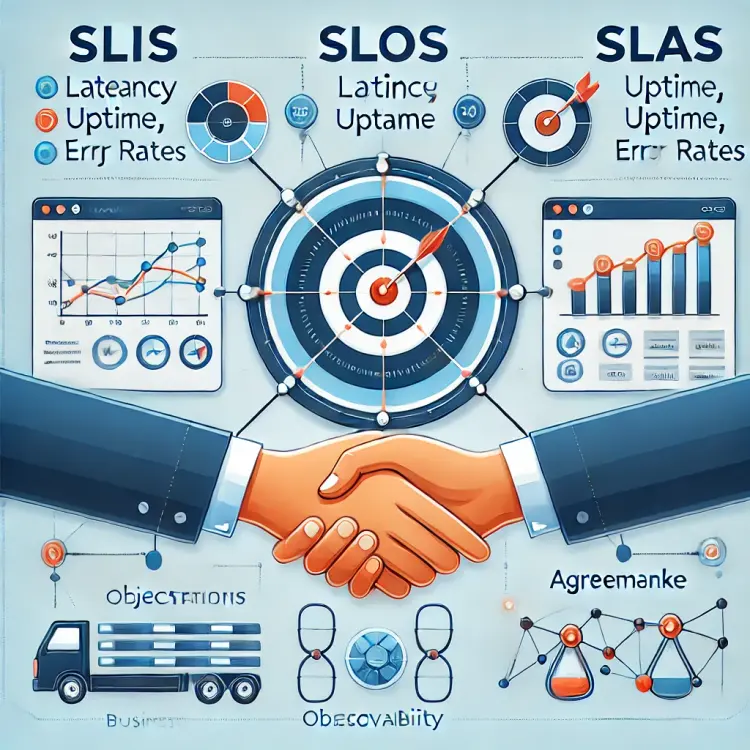
Understanding SLOs, SLIs, and SLAs: A Complete Guide for Modern Observability
Learn how to implement and optimize SLIs, SLOs, and SLAs for your business. Discover best practices, actionable tips, and how observability tools can enhance system performance and reliability.
Service Level Objectives (SLOs), Service Level Indicators (SLIs), and Service Level Agreements (SLAs) form the backbone of effective observability and performance management. Yet, many organizations struggle to implement these concepts effectively. In this article, we’ll break down the differences between these three critical components, explain how they interconnect, and provide actionable insights to help your teams adopt them successfully.
What Are SLIs?
SLIs (Service Level Indicators) are quantitative measures that reflect the performance of a service. Think of them as the metrics that track how well your system is performing against specific parameters, such as:
• Latency: How quickly does your system respond to user requests?
• Availability: Is your service accessible when users need it?
• Error Rate: How many requests fail or return incorrect responses?
For example, if your e-commerce platform processes API requests, your SLI might track the percentage of successful responses within a given timeframe.
Best Practices for Choosing SLIs
1. Align with Customer Impact: Focus on metrics that directly affect user experience, such as page load times or uptime.
2. Start Simple: Choose a small set of indicators that represent your most critical services.
3. Use Meaningful Thresholds: Define thresholds based on user expectations and business goals, not arbitrary values.
What Are SLOs?
SLOs (Service Level Objectives) are the targets you set for your SLIs. They represent the desired level of performance you aim to deliver to users.
For instance:
• “99.9% of API requests must succeed within 200 milliseconds over a 30-day period.”
SLOs are essential for setting clear expectations and prioritizing resources. They help teams focus on maintaining performance where it matters most.
Why SLOs Are Crucial
• Drive Business Decisions: Use SLOs to prioritize engineering work and balance innovation with stability.
• Prevent Burnout: Setting realistic targets ensures teams focus on achievable goals instead of striving for unattainable perfection.
• Improve Incident Response: SLO breaches can act as a signal for immediate attention, reducing downtime.
What Are SLAs?
SLAs (Service Level Agreements) are formal contracts between a service provider and its customers, detailing the promised level of service. SLAs often include penalties for failing to meet the agreed standards, such as financial reimbursements or service credits.
An SLA might specify:
• “The service will maintain 99.9% uptime per calendar month. Failure to do so will result in a 10% service credit.”
Key Differences Between SLAs and SLOs
While SLAs are external, customer-facing agreements, SLOs are internal targets. Think of SLAs as the promises you make and SLOs as the way you measure your ability to keep those promises.
SLAs ensure that accountability is maintained between service providers and clients, which is particularly critical for ensuring compliance in regulated industries.
How SLIs, SLOs, and SLAs Work Together
Understanding the relationship between SLIs, SLOs, and SLAs is key to building a robust observability framework:
1. SLIs provide the data needed to measure system performance.
2. SLOs define the targets for those measurements.
3. SLAs formalize the commitment to meeting those targets.
For example:
• SLI: 99% of requests are processed within 100 milliseconds.
• SLO: The target is to maintain this level for 99.5% of the time.
• SLA: If uptime drops below 99.5%, the customer receives a 10% credit.
Organizations rely on these metrics to anticipate challenges and build more resilient systems, aligning with emerging trends shaping observability in 2024.
Steps to Implement SLOs in Your Organization
1. Define Your Critical Services: Start by identifying which services are most important to your users.
2. Select Relevant SLIs: Choose indicators that align with user expectations and business goals.
3. Set Realistic SLOs: Establish achievable performance targets based on historical data and customer needs.
4. Monitor Continuously: Use observability tools to track performance in real-time and identify trends.
5. Iterate Regularly: Revisit your SLOs and SLIs to ensure they stay aligned with evolving business and user requirements.
Common Challenges in Managing SLOs
1. Overcomplicating Metrics: Avoid tracking too many SLIs, as this can lead to confusion and diluted focus.
2. Unrealistic Targets: Setting overly ambitious SLOs can demotivate teams and lead to burnout.
3. Neglecting Customer Feedback: Ensure your targets reflect actual user expectations, not just internal priorities.
How Observability Tools Can Help
Modern observability platforms like New Relic, Elastic, or Grafana simplify the process of defining and tracking SLIs and SLOs. Key features include:
• Real-Time Monitoring: Gain insights into live performance and user experience.
• Alerting: Automatically notify teams when performance deviates from SLOs.
• Historical Analysis: Review past performance to refine your objectives.
These tools provide a centralized view of your system’s health, enabling faster incident response and long-term
How We Can Help
In today’s complex digital landscape, effectively implementing and managing SLIs, SLOs, and SLAs is crucial for delivering reliable and high-performing services. By understanding and applying these concepts, your organization can set clear performance targets, monitor service health, and build trust with your customers.
At O11yAI, we specialize in observability solutions that empower businesses to achieve their reliability and performance objectives. Our platform offers comprehensive tools to define, monitor, and manage your SLIs, SLOs, and SLAs, ensuring your services consistently meet user expectations.
Ready to enhance your service reliability? Contact us to learn how O11yAI can support your observability journey and help you deliver exceptional digital experiences.